Primary Research
Books:
Two pieces of research that have been instrumental to the development of my project have been Screenplay: The Foundations of Screenwriting by Syd Field and Joker: The Official Script Book – the published version of Todd Phillip and Scott Silver’s script for Joker (2019). The former was a detailed introduction to the process of screenwriting, going in depth on how exactly a script is structured and how it tells its stories in comparison to other formats, like prose.

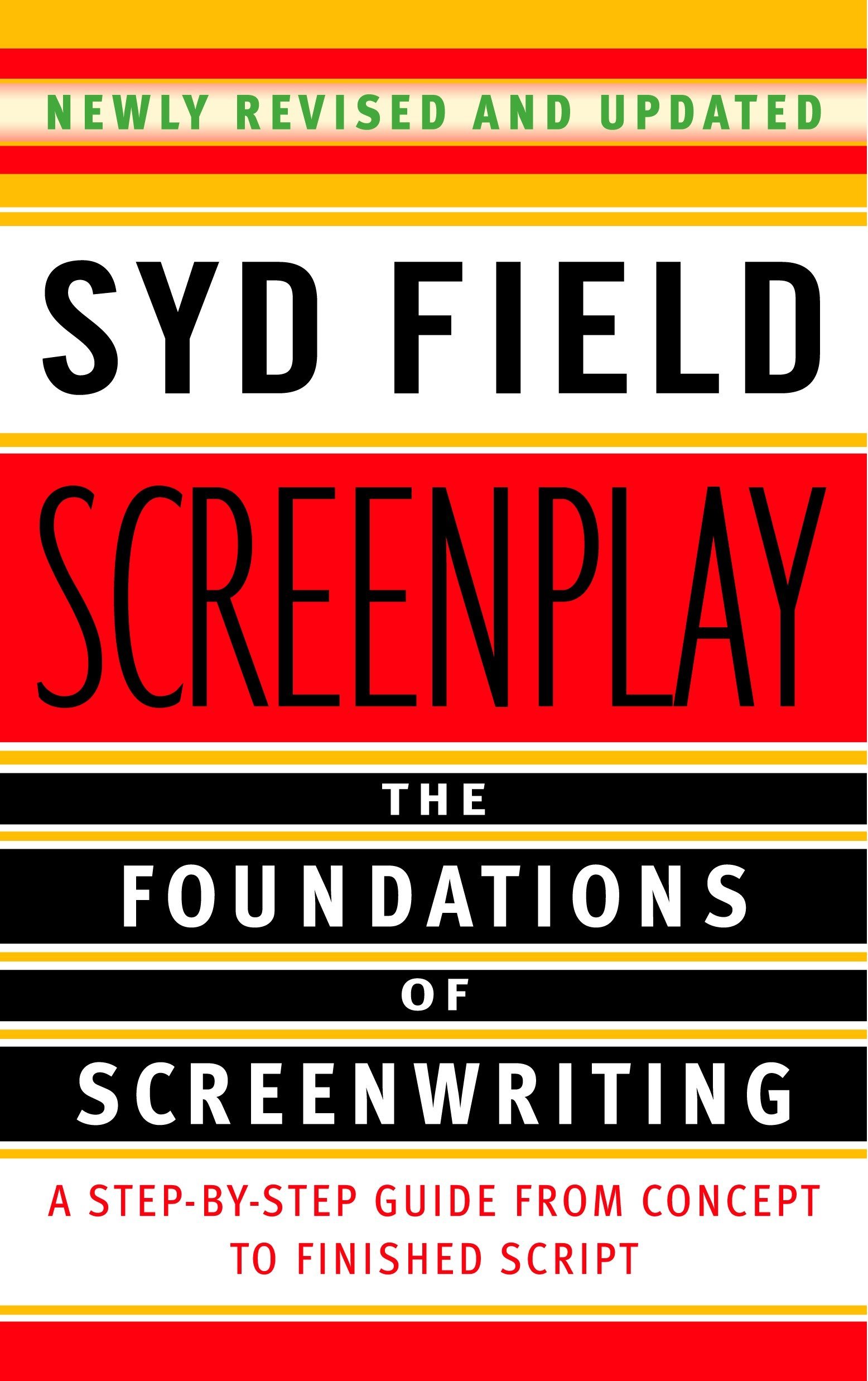
Traditional prose is the style of writing I am most comfortable in. It is the format I used to create my first characters and worlds at the age of thirteen when the idea of writing first truly piqued my interest. It has only been these last two years at college that I finally stepped out of my comfort zone, experimenting with other types of media to write my stories. That is why this book was so important. Although I have spent my second year on this course researching films and scripts to write films treatments and monologues, I felt I still needed a bit of a helping hand. Field makes use of a number of examples in this, such as Pulp Fiction and Blade Runner, which better contextualised the advice on offer.
One of the chapters I paid the most attention to was his discussion on acts. The differentiation between acts in any story is one I sometimes struggle with. Pacing my writing with a clear beginning, middle and end that all flow into each other naturally is a skill I need to practise and Fields writing on where these form in a script was a great place for me to start.


The second book I read, Joker: The Official Script Book, was an excellent reference when it came to formatting my script. Joker may not be a film that relates to the content of my project thematically, but it was an easily accessible resource that not only gave me an opportunity to get better accustomed to terminology used in a script but also how to craft a tight, complex story over all.
As mentioned previously, screenwriting is a fairly new process to me despite my forays into it over this course. From Joker I learned when and how to include directions on shots, ways to transition between scenes and how to present more complex concepts (e.g. montages). It was a constant reference for me that I made use of right up until the end of my project.
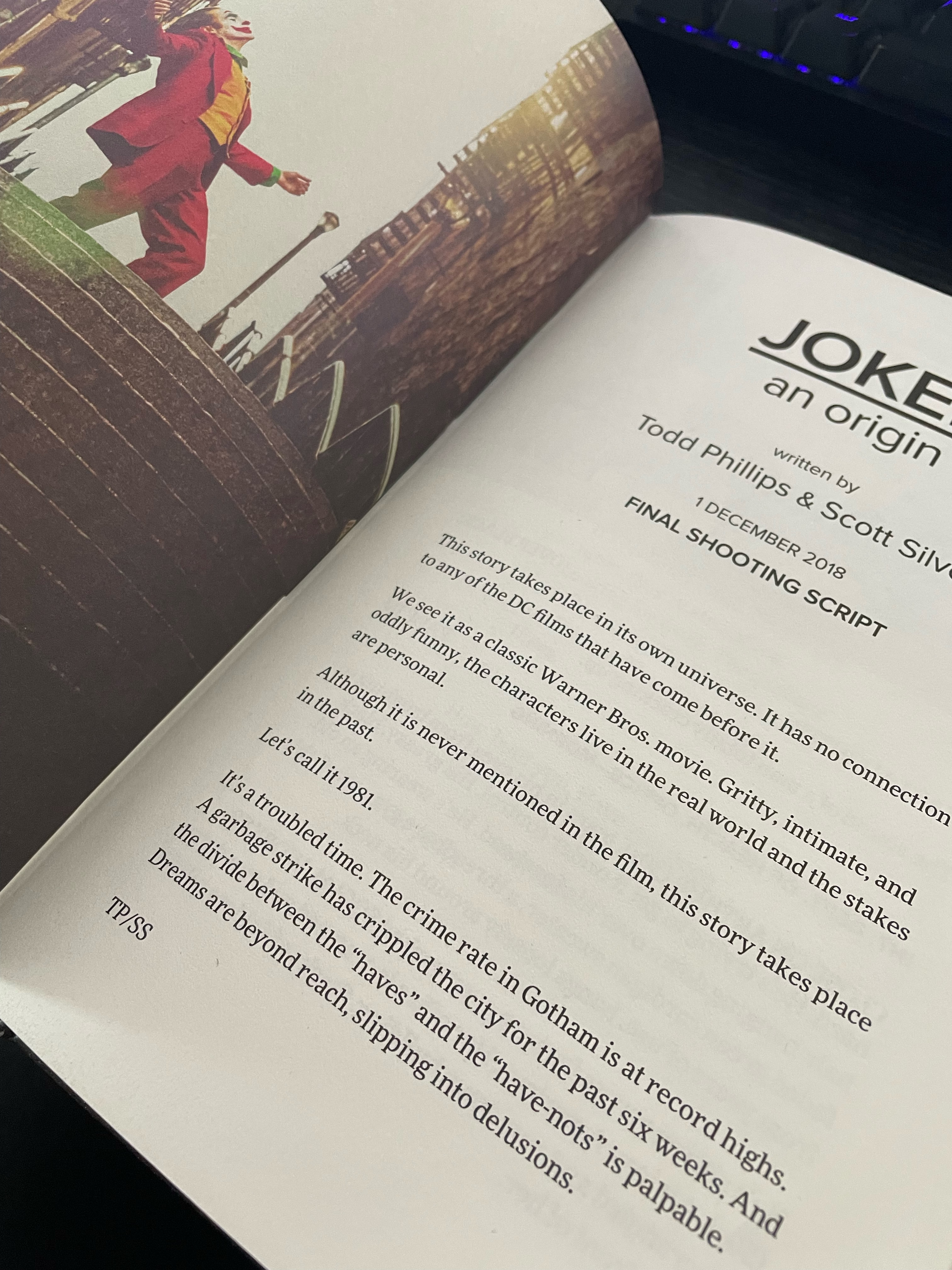
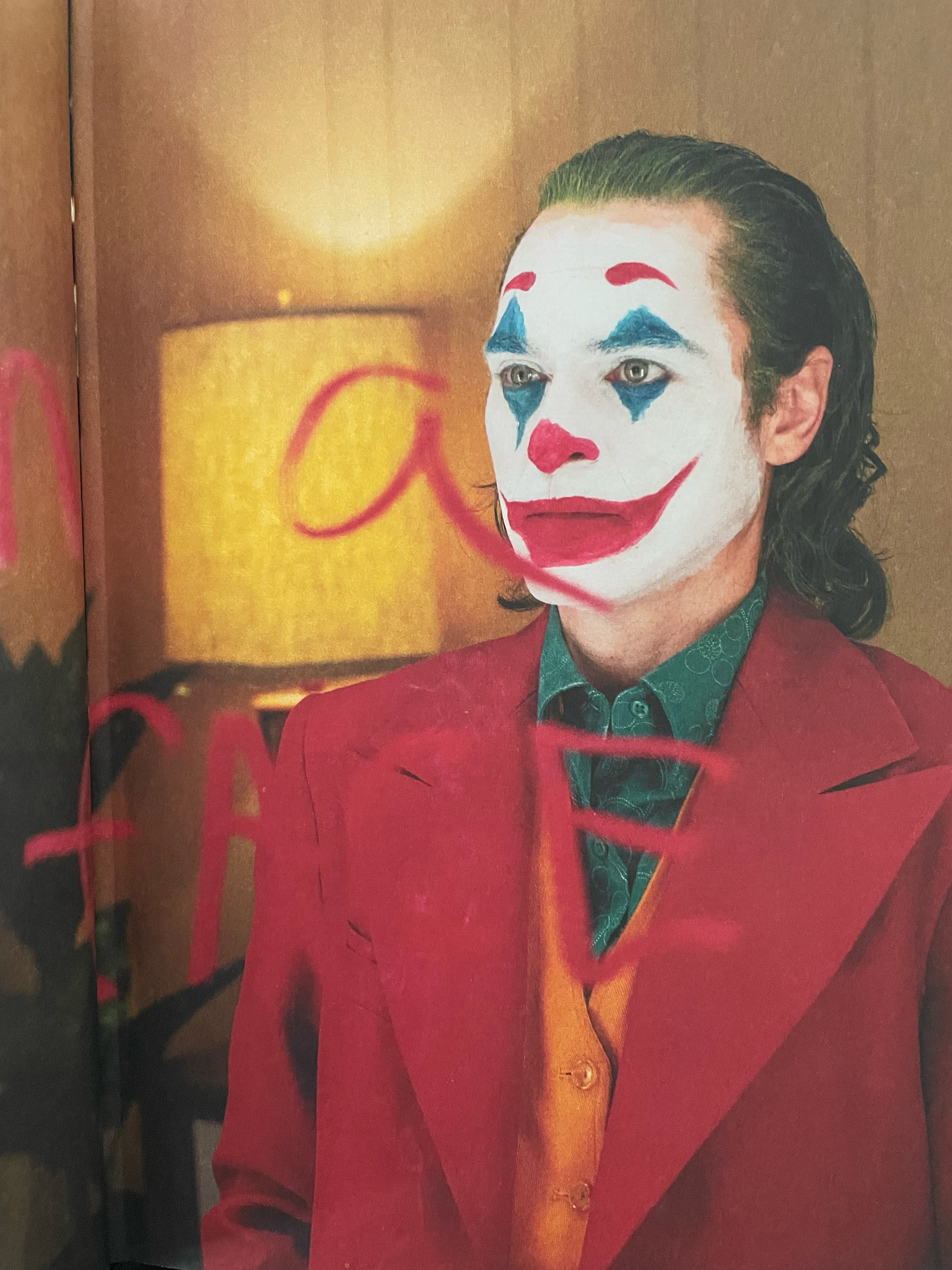
Paris:
My trip to Paris back in April with the college was another source of research that aided me during the development of my script. While the city was full of many beautiful sights which alone could have acted as inspiration for a story, it was the ECU 2023 Film Festival we were there to see that was the most influential on me.



Naturally, when writing my own short film, watching and understanding other media in the same format quickly became a process I practised regularly throughout my FMP. Which made the film festival that much more beneficial to me as it mostly featured other short films from independent creators from all across the world. These films weren’t just an example of how to pace a story in a short time frame, but also an example of the type of content that comes with culture I am not familiar with.
Being born and raised in Britain, my exposure when it comes to film has been from more mainstream sources in the west, like Hollywood. Besides a few popular standouts in recent years, such as Parasite (2020) and Incantation (2022), it is not often that I interact with films outside of this bubble let alone ones created by indie filmmakers. The ECU was a chance for me to experience these films that I don’t often seek out and has encouraged me to do so more in the future.

Ferrarrie from dir. Boris Biaou was a standout among the films. Opening with the story of two ordinary people falling in love, Ferrarie takes a dark turn that is both sickening and powerful, smartly subverting the audience’s expectations without it feeling unjustified. During this project I have made reference to the Scream franchise for its subversion of the horror genre which is why Biaou’s film has stuck with me for as long as it has. These pieces of media, while wildly different tonally, make use of storytelling techniques that I am interested in and have taken the effort to include in my own script.
Cyrus Neshvad’s The Red Suitcase (2022) was another highlight during the festival for its tense, edge your seat sequence absent of the action seen in traditional thrillers. It tells the story of a girl sent to Britain against her wishes for an arranged marriage. In order to escape this fate she has to abandon her passion and her faith and step out into unfamiliar territory all on her own. It was a moving piece and another example of a director making the most of the short form structure of these films. Since I am creating a horror script featuring a number of intense scenes, I looked to the film for inspiration for how to create sequences without an over reliance on the supernatural or fantastical ideas.
Guillermo del Toro’s Cabinet of Curiosities:


Guillermo del Toro’s Cabinet of Curiosities (2022) is a horror anthology series that tells eight separate stories contained within the run time of the typical episode from say, Game of Thrones (2011-2019). In my FMP logs I mentioned that I had to extend the originally planned length of my script to accommodate my characters and my plot as I felt that 20-30 minutes worth of script wasn’t enough. I, however, still didn’t want to transition the script into a feature length piece as I felt that I didn’t have the time to properly do so.
So, as a result, I looked to Guillermo del Toro’s Cabinet of Curiosities. Eight 45-60 minute stories that all explored various aspects of the horror genre. It was the perfect reference to look to when it came to extending my script, the bridge between a typical short film and a fully fledged feature. It gave me a better understanding as to how to pace my story, balancing intense sequencers with the moments of respite that followed.
The Autopsy, my personal favourite out of the anthology, is an episode I focused on in particular. Featuring a skeleton crew cast, mostly set in one location and a blending of horror themes, this was an episode I felt that I could attribute my own work to despite it firmly being a sci-fi horror rather than a slasher. The characterisation of both its protagonist and antagonist within its limited run time was impressive, managing to maintain intrigue until the credits rolled.
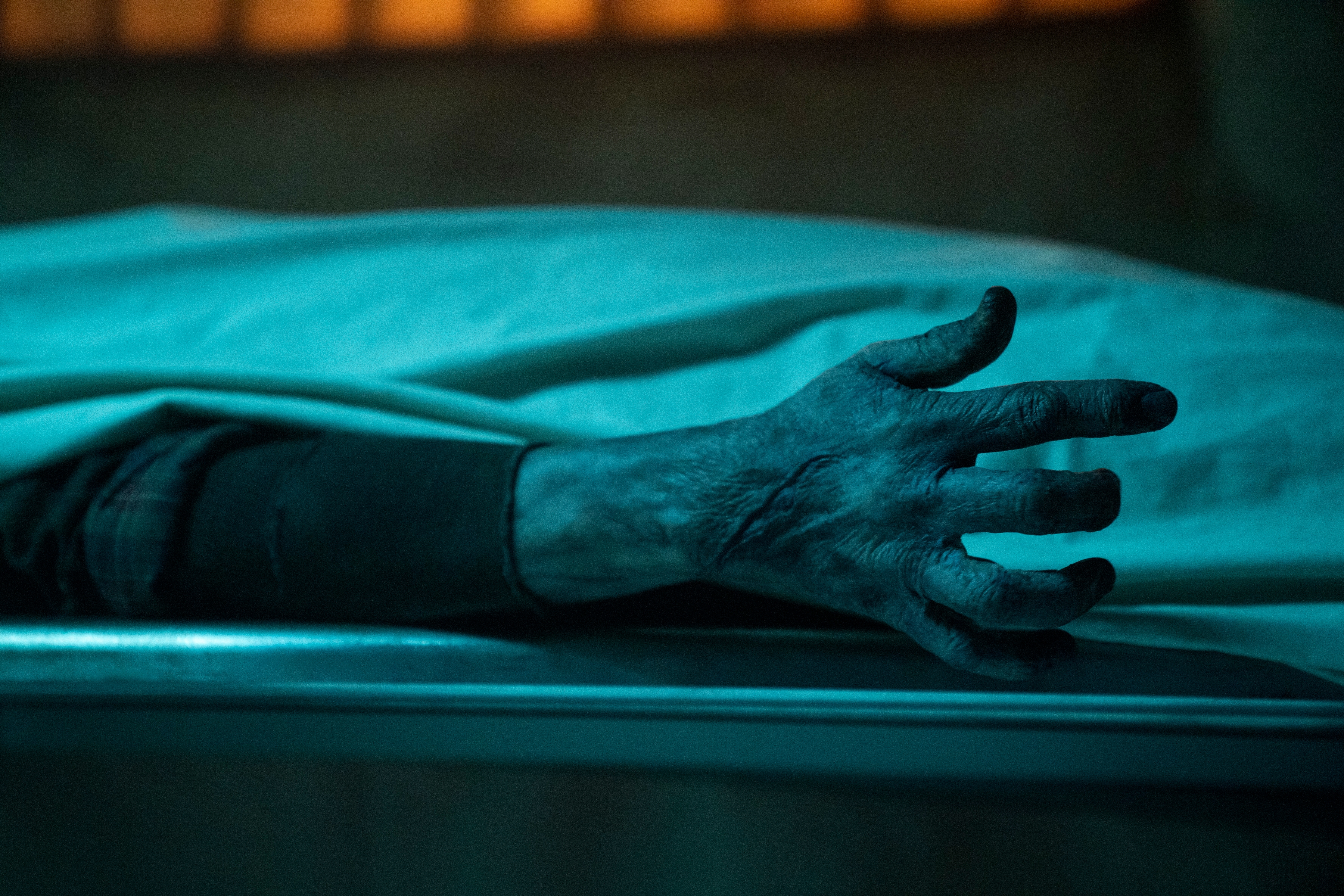

Feature Length Films:
Scream
Scream 6 (2023) was the inception of my final idea for my FMP. Back in March when my original plans had fallen through, I was lost as to where to take the project. I couldn’t salvage my original idea as it was so closely tied to my trip to Tenerife and I couldn’t return to my project last year, as I felt I didn’t have the time to create an extension of it that was large enough to stand on its own.
But amidst this, when I had the opportunity to sit down and watch Scream 6, I was reminded of how much I loved the slasher genre and of what can be achieved within it. The film felt tight with creative sequences and an earnest story and, unlike its predecessor, celebrated what came before without feeling like it was pandering to the audience. Watching this film dredged up old and scrapped script ideas that I had come up with earlier in the course and gave me a chance to breathe new life into them.
I suddenly wanted to create my own slasher set within a movie theatre (a setting I will discuss later) with a flair of the supernatural that is prevalent within my writing. And just like that, the next two months of my production was laid out before me.
I returned to two other films in the franchise, the original – Scream (1997) – and its sequel – Scream 2 (1998). Through these films the franchise established a reputation for subverting expectations and picking apart the horror tropes prevalent at the time of its release, doing so through its black comedy and clever 4th wall breaking nods to the audience. These tropes in question were those spawned from other classic slasher franchises that started to feel bloated and repetitive thanks to their lack of innovation. It poked fun at Friday the Thirteenth’s sex hating villains, mocked the clueless characters that often took the spotlight in horror movies and cut down “final girl” material. All the while layering it’s dialogue with self-aware comments about the nature of horror films itself and celebrating them. While these days, the rules broken in Scream have become a trope in itself thanks to its multiple instalments and overall longevity, it is still the slasher genre at its best.


Besides from a few hints and nods, when writing my script it was not my intention to pick apart the current climate of the horror genre. Instead, my focus was on the current work culture of today and interpersonal struggles relating to guilt. Despite this, Scream was still an excellent resource for me, not just for ideas on the baser concepts of a slasher, but also how I might similarly use comedy and horror to pick apart the themes of my story and subvert expectations.

Ghostface, the series infamous antagonist, was also a massive inspiration behind my villain: The Director. Ghostface, despite still being very human, possesses such an imposing physical presence in each film for their extreme lethality and voicework by Roger L. Jackson. Scenes where they are on screen became a persistent reference for me when it came to writing more action heavy scenes, even if my villain eventually adopted a more monstrous nature during the development of my script.
Halloween
Halloween (2018) is a film I made constant reference to – for good reason – while writing a film treatment for a different project last year and, once again, it has acted as another source of inspiration for me during this one.
Asides from a couple of iffy character motivations, Halloween (2018), is a film with no fat on its bones. Its script is concise and full of sequences that, like Scream, emphasises the physical threat of its main antagonist: Michael Myers. Through its infamous villain, Halloween has always been a franchise that blurs the line with fiction and reality, bringing into question the nature of Michael. This was originally the approach I was going to take with my antagonist but I eventually leaned towards a more direct approach.


Still, this film felt like a pillar of my inspiration. It managed to achieve one of my favourite things about the horror genre. It told an earnest, familial and down to earth story wrapped up in its more elevated and reality defying ideas. I love when horror is used as a vessel to tell real world stories that become accentuated and expanded upon by its gruesome tropes. It’s what horror does best: creating a bloody reflection of the truths of our world rather than only trying to scare the pants off you.
Evil Dead Rise
The final feature length film worth mentioning in my research is Evil Dead Rise (2023). Like Scream 6 I watched this film for the first time during my FMP and after I did there was a noticeable shift in my writing.
I had always planned for my villain to be a mixture of the traditional slasher villain and the supernatural. But after watching Evil Dead Rise I found myself, somewhat subconsciously, altering my antagonist to be closer to the latter. The original concept was there but the scales had shifted, treading into creature-feature territory.
I believe this was thanks to Alyssa Sutherland’s performance as Ellie and the star deadite (the creatures that act as the series’ antagonists). The character’s monstrous brutality was enthralling, darkly funny and urgent. She was a villain that was there to get the job done – no filler. In a series five movies deep, each with the same monsters, Sutherland’s portrayal was dangerous and easily stood above the rest.


And within all of this was still a human presence, warped and twisted. Making it feel all the more unsettling. I fell in love with the idea and began to wonder how I could incorporate it into my script in a way that felt unique. I revised the supernatural elements tied to my villain and tried to expand upon them. Suddenly, I felt that I was giving this character more character through its movements alone. I fleshed out its abilities but still found a way to leave their nature up in the air, creating – I hope – a greater sense of mystery.
As this change in my script occurred I did begin to worry that I was losing sight of my original idea and that I was purely working off of a recency bias. Gradually, I managed to put these fears to rest after realising. . .Just how much fun I had writing this new version of my villain. I became more excited to write big confrontations with my villain and delighted in every new way I could think to use it. It was a positive feeling that I couldn’t help but think meant positive things for my script, so I continued to chase it.
Evil Dead Rise is also another film a part of the legacy sequel trend – sequels that come out years or even decades after their predecessor – that is currently widespread in the industry. Scream and Halloween are two other franchises that have undergone the same transition. Like some sequels, however, Evil Dead Rise didn’t feel unnecessary. It finally moved the series from the woods and into the city. There are various sequences in the film that make the most of this resident setting, like the claustrophobia of the apartment the film primarily takes place in or the simple reality of a deadite reaching civilization. But what I want to focus on is how this setting is reflected and utilised in the plot. Ellie (pre-deadite) is a mother of three who has recently separated from her partner. Her family are clearly feeling the aftershocks of this and when the protagonist, Beth, arrives those ripples only get stronger. Beth herself has recently discovered that she’s pregnant too which acts as another of the film’s emotional cruxes. Like Halloween, these plot points come together to tell a relatable and familial story that feels perfectly suited to its environment. Evil Dead Rise transports us to a familiar location to tell us a familiar story.


Though not particularly profound, the way all these elements bounce off each other created an airtight script. This is an effect I hope to achieve in my writing, by making the most of my setting to reflect the idea of guilt which sits at the centre of my character’s arcs and also hint at larger themes such as “the death of cinema.”
The Quarry:
In my script I wanted to subvert expectations by creating the impression of a slasher movie when going in blind before unravelling more and more into the supernatural. The most recent piece of media that plays around with genres and the audience’s expectations like this that I can think of is The Quarry (2022) , from Supermassive Games. This developer is well known for their story driven horror games inspired by their cousins in the movie industry. Players take control of a cast of characters where they decide their dialogue and actions which can have rippling effects on the outcome of the story.
I mention The Quarry specifically as the game takes a while before revealing what it actually is. For the first few hours you don’t know if you’re in for a slasher, a ghost story or a creature feature. Eventually it reveals itself to be a spin on werewolves but getting there takes time, leaving the player in suspense as they try to unravel the mystery themselves.
While gathering my research and inspiration for this project, I replayed the first couple of hours of The Quarry to experience this descent once again. I realised that even when the monsters show up and start snacking on your characters, it still isn’t clear that they are werewolves due to the game mostly keeping them obscured in shadows for the first few chapters. Their design is quite misleading too. Hairless, skinny and humanoid faces make these creatures closer in design to the Wendigos from one of Supermassive’s previous games, Until Dawn (2015), rather than their source material.

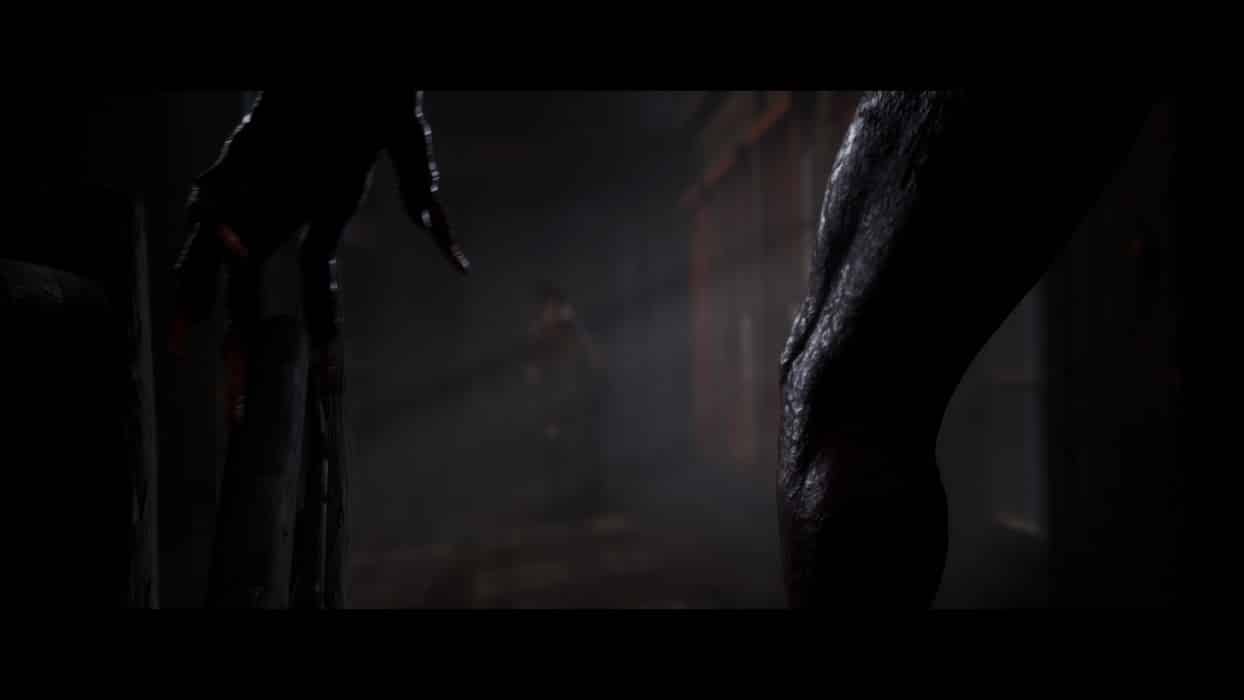
This wasn’t a frustrating choice made by the developers, however, and – again – only heightened the mystery of the game. It made me consider how I might approach my own villain.
Cinemas:
In my town there is an abandoned cinema called: The Galaxy Cinema. It has been closed and bordered off since 2012 with two of the last films it ever featured being: The Hunger Games (2012) and The Woman In Black (2012). I often hoped that it would one day get its grand reopening. Going to the movies was always an exciting experience for me. It’s where I watched the first film to ever make me cry (embarrassingly it was the second Michael Bay Transformers movie – I was six and I had just watched Optimus Prime kick the bucket, okay?). It’s where, later on in my life, I developed the yearly tradition of watching Star Wars with my family, making me feel closer to them than I had in a while. It’s where I learned to love movies.


My hopes of the cinema opening again eventually turned into dreams of owning it. I thought, when I was older and had – obviously – become a millionaire, that I would come back to Long Eaton and reopen the cinema myself, turning the town into a hotspot.
But as I got older and started to write, everytime I walked past that cinema I instead thought of telling a story about it. One about spelunking an old relic and escaping for a while. This was a seed of an idea that sprouted earlier this year at college. I returned to this tomb-raider-esque story and even attempted to arrange filming in the galaxy cinema itself.
Those plans would unfortunately fall through, however, it was around this time that I had just seen Halloween Ends (2022). Walking out of the theatre I noticed just how empty the place felt. Hardly anyone had come to see the film. Maybe that was because it was a late screening or because the film just wasn’t very good. Still, the emptiness felt eerie. Like walking through a deserted supermarket in the early hours of the morning. I noticed this happened more and more when I went to the movies and thought back to other instances in the past where I might not have paid it any mind.
All of sudden I became obsessed with the idea of writing something set in a cinema all over again. A film that would play on this exact feeling. And that’s where Flicks came from. No longer about an abandoned cinema, but rather one on the cusp of becoming one.
Naturally, when it came to working on this project I immediately visited places like Arc cinema in beeston, Cineworld in Nottingham and – of course – the Galaxy Cinema in my hometown. I needed to take photos and figure out what rooms are actually in a cinema to create a floor pan for my own that felt authentic.





I had also hoped to interview a staff member at one of these cinemas to gain a better insight on what it was like working there. Unfortunately, I wasn’t able to secure any interviews so I turned to online forums instead.
Secondary Research
Reddit:

Not being able to interview anyone from a cinema, I decided that I was going to open a forum on Reddit and hopefully get my answers there. Fortunately, every question you could think of has already been asked on the site by someone else and before I even made my own post I had already found a handful with the same questions as me. I skimmed through these posts and found that the information satisfied what I was looking for, so, needing another source for my secondary research, I settled on these forums instead.
Specifically I looked at a post from user directorof1 on the r/movies page who asked as follows:
“I’m 16 and looking to make some extra money. I’m aware of what I’d have to give up due to having less free time, but I think it would be worth it to get some experience before university. Working at a cinema feels like an obvious choice to me because I love films and filmmaking. Although I have no idea what it’d be like to work there. So if anyone here has had experience working in a cinema, please let me know what it was like. How long were the shifts? Was it ever too much to handle? What were the benefits? How were the co-workers? What position did you have? Any little details or stories would be great thanks!”

Though this user asked these questions with different intentions than I, I still found them useful all the same. Some of the answers to their questions provided me with the exact insight I was looking for, like this response from user thebugman10:
“My first job was at a movie theater in 2006. Pretty much did everything except projectionist (wanted to be a projectionist, but wound up not staying there long enough), depending on what I was assigned that day. Ticket counter, concession, usher, ticket taker, you will do it all. Working concessions was definitely the worst. I didn’t mind working in the ticket counter, but it could get boring. Usher wasn’t bad, but ticket taker was the easiest.
As with most retail like jobs, newer people get worse hours which usually meant closing. When closing, especially on Friday or Saturday, it would sometimes be 1 am before I left. The pay sucked, at that time I made $5.50/hour and minimum wage was $5.25. But I was 16 so I didn’t really care that much.
I got tired of movie theater popcorn and couldn’t eat it for probably 10 years after. Overall I really like the job. I like the atmosphere of movie theaters. I liked popping into a theater to watch a good scene of a movie. I liked getting to see all the movies I wanted for free.
On Thursday nights, we got to preview movies before they came out on Fridays (back then the only movies I remember having midnight shows were Spider Man 3 and Pirates of the Caribbean 2, so most movies debuted on Friday). But before the movie premiered, the projectionist had to make sure the actual film was good, so all new movies would be shown on Thursday nights, and the employees got to watch too. This was my favorite part of working there, getting to see all the new movies before anyone else.
Overall it was an awesome experience for a first job.”

I combined this new found insight with my own experience working as a bartender to write a work environment that felt realistic and believable. Though working as a bartender has quite a few differences with a cinema host, I identified enough correlations and universal situations to establish a sense of authenticity.
David Lynch:
Another area of my research came from a feature with David Lynch on the YouTube channel, Frame Into Focus. Specifically, a two minute segment wherein Lynch shares his process on writing and planning a script. He answers the question “How did you learn to write screenplays and what was your first script?” by stating that screenwriting is mostly based on “common sense.” I found this to be a surprisingly comforting statement when it came to starting the development of a script, allowing myself to trust my own abilities a little bit more.
The highlight of this video, however, is when Lynch goes on to talk about a writing technique he learned from Frank Danielle where you write an outline of each of your scenes on a piece of card and “when you have seventy, you have a feature film.” After hearing about this method myself I decided to test it myself, creating a rough plan of my script on separate pieces of paper. The process worked, I suddenly found the idea of writing a script far less daunting and that I was coming up with brand new scenes I hadn’t originally planned for.
It was a breezy process where I could get the ideas bouncing about in my head onto paper, without fretting about detail or presentation. It was messy and looking back the plans I made while creating those panels have undergone a plethora of changes, but ultimately it still acted as a sturdy foundation which I built upon right up until the end of my project.
Lessons From the Screenplay:
Lessons From the Screenplay is a YouTube channel that, would you believe it, is about screenplays; featuring a plethora of videos that break down some of the greatest scripts from recent years, explaining what exactly makes them so great. This channel has been a useful resource for me throughout the entirety of my course, from my first year of College when I was learning about the differences between scripts from different media to now where I have once again used the channel to help improve my writing for my FMP.
One of my favourite videos I love to refer back to is their piece on Gone Girl – Don’t Underestimate the Screenwriter. They highlight the brilliant simplicity of short and sweet directions in a script that give actors all they need to accurately portray the intended emotion. Trimming the fat off a script and killing your darlings is a process I still need to practise in and this video is a reminder of how to do that.
This same video also introduced me to “The Upside Down Triangle,” an idea that suggests each scene should funnel down to a single and important point – naturally convey the intention and context of the scene.
I tried to make use of this technique throughout my script while referring back to my previous notes on this videos and the techniques discussed: https://witchersandwitches.wordpress.com/2021/12/13/comic-book-scripts-versus-film-scripts/
Moodboards
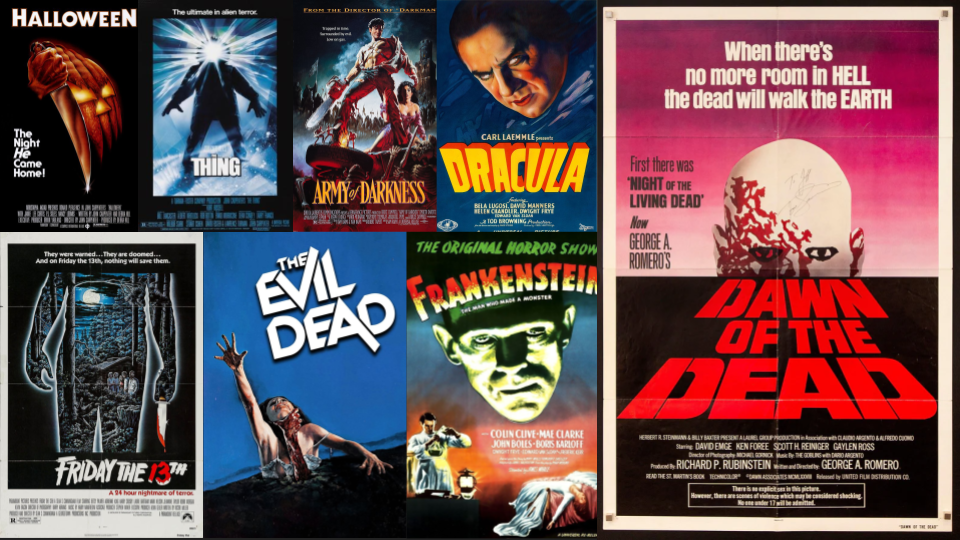
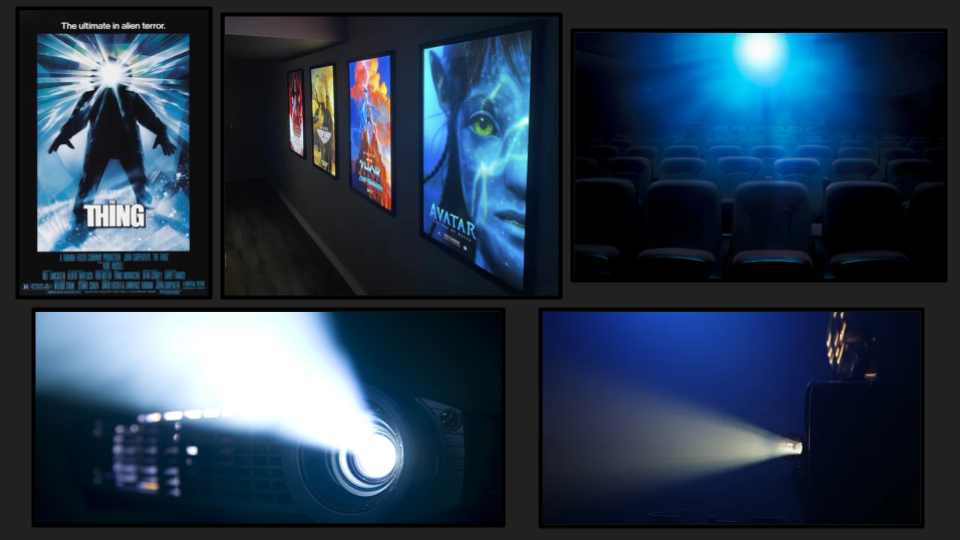
For the production side of my project I wanted to create a movie poster for my screenplay as I, unfortunately, did not have time to film any test footage or create a set of illustrated storyboards. I originally planned to create a piece that harkened back to classics of the 70/80s pushing on towards the Universal monster era. I adore the grainy and pulpy aesthetic of these posters and felt that it matched my script tonally. Rather than creating a one for one recreation of these designs, I would have tried to illustrate a poster that utilised my setting. Taking a still image of a gallery of posters from a real cinema, I would create a handful of fake posters to replace the frames – each one featuring a character or narrative device from my script.
I also had another idea based on the poster for The Thing (1982) and a number of images of theatres I gathered while looking for references. In these images is a sort of lens flare effect that I became interested in. I would have used a combination of photography and graphic design to recreate one of these scenes and then draw in characters in each ray of light.
However, during this brainstorming process, I took a step back and reassessed my ideas. While I do think I could have seen these ideas to fruition, I do not have the skill to complete them in time for the project due date. I needed to take a different, more minimal approach.
When I talk about a minimalist design I do not mean the style that has become prevalent in the marketing in a lot of modern companies. Instead I wanted to look for posters that adopted this design philosophy while also maintaining their own distinctive style with few but interesting details.

The works (top row) I collected for this moodboard all feel minimalist but unique in their own right. The poster for Nosferatu (1930) recreates the vampire’s iconic silhouette with words over a grainy background, saving it from feeling blocky. Carrie (1976) references the film’s most popular scene through its text and imagery; The Cabin in the Woods (2011) uses a mirrored effect to make the most of its simplistic design; Scream (1997) combines the iconic visage of franchise’s villain with his preferred weapon; Seven (1996), like Carrie, references its most iconic scene as well as reflecting the films title.
In collecting images for these moodboards, I was reminded of an artist who perfectly encapsulates everything I was looking for: PITCH CANKER. Aesthetically, their work has been a massive inspiration for me. I am fascinated with how they make the most of their limited colour palette and how their sketch-like line work manages to convey intense emotions with each piece rather than the impression of something messy or unfinished. I also have a strong emotional connection to a few of their pieces.
For my last FMP I, like this one, had planned on telling a story about guilt – though in a much different context. It is a theme that endlessly interests me from a storytelling point of view due to all the different avenues you might be able to take such an emotion. I can also attribute it to a number of past personal events in my life.
Ultimately I decided on a different theme for my FMP last year but that desire to tell this kind of story stayed with me. It was PITCH CANKER’s piece, “Guilty,” that dredged that desire out of me once again earlier this year. Despite being one of their less visually complex pieces, I immediately felt a connection to it beyond its aesthetic and style.

Pingback: FMP Year 2: Evaluation | Witchers and Witches